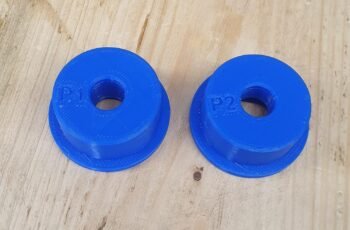Ad Blocker Detected
Our website is made possible by displaying online advertisements to our visitors. Please consider supporting us by disabling your ad blocker.
When you’re starting out in welding, choosing the right machine can make all the difference. You’ll want something user-friendly and versatile, like models that handle MIG and Stick welding. These options offer easy setup and digital interfaces to simplify adjustments. Plus, with budget-friendly choices and essential safety features, you’re set for a smooth learning journey. Curious about which welding machine suits your needs best? Let’s explore your options further.
Multi-Process Versatility for Beginners
When you’re starting out with welding, having a machine that’s versatile can make all the difference. You’ll want a welder that supports various processes like MIG, TIG, and Stick, allowing quick process switching without changing equipment. This flexibility lets you handle multiple arc welding applications, such as GMAW, SMAW, and GTAW. Adjustable polarities (AC/DC) cater to different metals, while reducing setup time between tasks. Material compatibility is crucial. With the right machine, you can weld steel, stainless steel, and aluminum, whether you’re dealing with thin or thick materials. Multi-process welders often come with built-in safety features, which enhance user protection and provide peace of mind while welding. Flux-cored options even allow you to work on rusty or dirty metal. Plus, using gas or gasless wires makes it suitable for both indoor and outdoor jobs, enhancing overall versatility.
Easy Setup and Maintenance
Setting up and maintaining your welding machine shouldn’t feel like a daunting task. Start by conducting pre-use safety checks: inspect power connections, feed cables, and tungsten electrodes. Verify inert gas supply and filler wire availability.
Regular maintenance keeps your machine running smoothly. Consult the manufacturer’s manual for specific guidelines on your welding machine’s maintenance requirements. Service air/oil filters every 50 hours and replace them after 100. Check and top up fluid levels every 8 hours; clean and tighten weld terminals biweekly.
Replace consumables like tips and nozzles when performance drops due to spatter. Weekly, clean drive rolls and feeders to prevent debris buildup.
Monitor filler wire stock, and store tungsten electrodes safely. For optimal performance, blow out compartments regularly and clean cooling systems, ensuring your machine’s longevity and efficiency.
Welding Machines for Thick Steel
After ensuring your welding machine is well-maintained and ready for action, let’s tackle welding thick steel.
For this, MIG welders are your go-to option due to their consistent wire feed and user-friendly nature. If you’re dealing with dirty or rusty surfaces, flux-cored welding is a great choice because it excels in such conditions. Stick welding is another traditional method that is ideal for repairs and outdoor environments, providing excellent results on thicker materials. Opt for 0.040/0.045 wire to maximize penetration and strength, especially in dense materials.
Inverter-based MIG welders offer adjustable settings, making them versatile for different steel thicknesses. You’ll need a welder with at least 200A power capacity to handle industrial-scale thickness.
Features like smooth start technology and thermal overload protection ensure efficiency and safety during prolonged use.
Budget-Friendly Welding Options
Finding a welding machine that fits your budget doesn’t mean you have to compromise on quality or functionality. Consider the YesWelder 200Amp, priced under $150, with automatic feed and voltage adjustment—perfect for DIY enthusiasts. If you need basic functionality, the Millermatic 142 offers 120V compatibility for under $500. For a versatile option, the Lincoln Electric POWER MIG 140MP handles both steel and aluminum. Stick welders provide an economical choice, eliminating costly shielding gas and suiting outdoor projects. Flux core welding also cuts expenses by nixing gas costs, ideal for steel under 1/8 inch. Compact models like the Hobart Handler 210MVP offer portability with multi-voltage plugs, enhancing flexibility for beginners exploring various power sources. Additionally, the ArcCaptain 200Amp is recognized as the best option for professionals, making it a reliable choice if you plan to transition from hobbyist projects to more serious work.
Safety Features and Durability Considerations
When selecting a welding machine, it’s essential to prioritize safety features and durability to ensure a reliable and secure experience. Look for machines with UL certification and OSHA compliance, which reduce fire and exposure risks. Built-in EMI shielding and arc interface systems with auto-shutoff enhance safety during use. Durability is key; choose machines with stainless steel construction and reinforced components like electrode holders. Weatherproof casings and heat-resistant parts ensure longevity even in harsh conditions. Ease of maintenance is crucial. Opt for machines with visual wear indicators and easy access to components. Automated thermal overload protection helps prevent damage. Ensure that welding cables and equipment are clear of pathways to avoid tripping hazards and maintain a safe workspace. Lastly, seek models offering digital manuals and beginner tutorials, ensuring you’re well-supported with safety protocols and diagnostics for a seamless welding journey.
Portable Welding Machines for Mobility
While selecting a welding machine, it’s crucial to consider portability, especially if you often move between work sites. Portable welding machines, like the Lincoln MIG models, weigh under 50 lbs, making them easy to transport. Their compact dimensions fit neatly into vehicles, and built-in handles ensure one person can manage them effortlessly.
With dual voltage options (120V/240V) available, you can seamlessly switch from home to workshop environments. Models like the Miller Multimatic 215 stand out with multiprocess capabilities and Auto-Set features, simplifying use.
Budget-friendly options like the S7 200Amp offer generator compatibility and four-in-one functionality. Don’t overlook energy-efficient presets, which allow operation with battery generators, enhancing mobility.
Prioritize these features to achieve flexibility without compromising performance.
MIG and Flux-Cored Welding Basics
Even as a beginner, mastering the basics of MIG and flux-cored welding can significantly enhance your skills.
Start with understanding MIG welding equipment: a wire feed system, shielding gas tank, and a welding gun are essential. Argon or CO₂ shields your welds, while the work clamp ensures a stable circuit.
Prepare surfaces by cleaning them thoroughly to prevent porosity. Maintain a 30° gun angle for consistent penetration and check your trigger’s response before welding.
Flux-cored welding offers a gasless option, ideal for outdoor work. Use E70T-4 wire for steel and adjust your speed for higher deposition rates.
Choose wire diameter based on metal thickness; larger wires deposit faster. Preheating thick steel can minimize cracking, ensuring a solid weld.
Introduction to TIG and Stick Welding Techniques
Exploring TIG and stick welding opens up a world of possibilities for creating strong, precise welds across various metals.
With TIG welding, you’ll use AC/DC power compatibility to tackle non-ferrous metals like aluminum, while maintaining your tungsten electrode sharp for optimal arc control. The inert gas shielding and foot pedal operation give you precision and protection.
Remember, surface preparation is key to quality results.
On the other hand, stick welding uses consumable, flux-coated electrodes suitable for thicker steels. It doesn’t require gas shielding, making it ideal for field repairs.
You’ll adjust the arc manually by controlling the electrode’s angle and speed. Post-weld, cleaning slag is crucial for inspection.
Begin with practice exercises and maintain a steady stance for better stability.
Digital Adjustments for Precision Control
Precision in welding is no longer a luxury but a necessity, especially when you’re dealing with delicate or diverse materials. Digital adjustments allow you to manage voltage, current, arc length, and travel speed with pinpoint accuracy.
With real-time pulse welding controls, you can fine-tune heat input for materials like aluminum, ensuring precision without overheating. Preset welding modes simplify operations, taking the guesswork out by automating ideal settings. You can customize multiple parameters through software to suit different materials and weld types.
Programmable settings let you input exact values, store custom recipes, and repeat welding sequences effortlessly. This means consistent results across projects.
User-friendly digital interfaces make this process intuitive, offering real-time monitoring and adjustments for optimal weld quality every time.
Essential Welding Accessories for Starters
Having precise control over your welding process is only the beginning; you’ll also need the right accessories to ensure safety and efficiency.
First, invest in safety gear: an auto-darkening welding helmet, flame-resistant gloves and jacket, safety goggles, steel-toe boots, and hearing protection. These safeguard you against sparks, loud noises, and debris.
Next, gather core tools like MIG welding pliers, a steel wire brush, chipping hammer, angle grinder, and welding magnets. These help in handling, cleaning, and positioning.
Don’t forget consumables: shielding gas, consumable tips, filler rods, replaceable nozzles, and grinding wheels for various tasks.
Precision tools like digital calipers and combination squares are crucial for accurate measurements.
Finally, workholding accessories—C-clamps, welding tables, and positioners—ensure secure and precise welds.
Conclusion
As a beginner in welding, you’ll appreciate a machine that offers versatility and ease of use. Opt for models with straightforward setups and digital controls to help you learn quickly and efficiently. Don’t overlook the importance of safety features and essential accessories like auto-darkening helmets. Whether you’re exploring MIG, Stick, or TIG welding, choose a budget-friendly option that handles various materials. With the right tools and features, you’ll confidently tackle any project.



